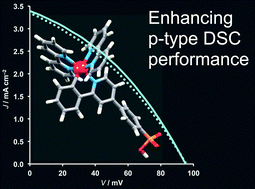Modular synthesis of simple cycloruthenated complexes with state-of-the-art performance in p-type DSCs†
Abstract
A modular approach based on Suzuki–Miyaura cross coupling and Miyaura borylation has been used to prepare two cyclometallated [Ru(N⁁N)2(C⁁N)]+ complexes which possess either a carboxylic or phosphonic acid group attached via a phenylene spacer to the 4-position of the pyridine ring in the C⁁N ligand. The key intermediate in the synthetic pathway is [Ru(bpy)2(1)]+ where bpy = 2,2′-bipyridine and H1 is 4-chloro-2-phenylpyridine. The crystal structure of [Ru(bpy)2(1)][PF6] is presented. Reaction of [Ru(bpy)2(1)][PF6] with 4-carboxyphenylboronic acid leads to [Ru(bpy)2(H6)][PF6], while the phosphonic acid analogue is isolated as the zwitterion [Ru(bpy)2(H5)]. The cyclometallated complexes have been characterized by mass spectrometry, multinuclear NMR spectroscopy, absorption spectroscopy and electrochemistry. [Ru(bpy)2(5)] adsorbs onto NiO FTO/NiO electrodes (confirmed by solid-state absorption spectroscopy) and its performance in p-type dye-sensitized solar cells (DSCs) has been compared to that of the standard dye P1; two-screen printed layers of NiO give better DSC performances than one layer. Duplicate DSCs containing [Ru(bpy)2(H5)] achieve short-circuit current densities (JSC) of 3.38 and 3.34 mA cm−2 and photoconversion efficiencies (η) of 0.116 and 0.109%, respectively, compared to values of JSC = 1.84 and 1.96 mA cm−2 and η = 0.057 and 0.051% for P1. Despite its simple dye structure, the performance of [Ru(bpy)2(H5)] parallels the best-performing cyclometallated ruthenium(II) dye in p-type DSCs reported previously (He et al., J. Phys. Chem. C, 2014, 118, 16518) and confirms the effectiveness of a phosphonic acid anchor in the dye and the attachment of the anchoring unit to the pyridine (rather than phenyl) ring of the cyclometallating ligand.



 Please wait while we load your content...
Please wait while we load your content...